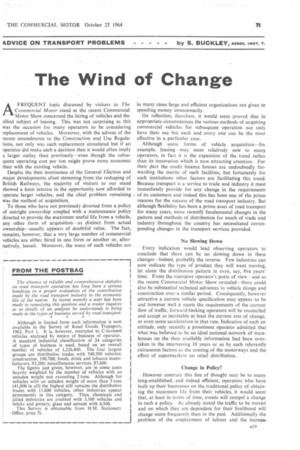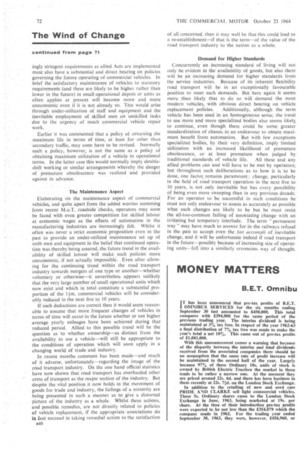The Wind of Change
Page 73

Page 74

If you've noticed an error in this article please click here to report it so we can fix it.
AFREQUENT topic discussed by visitors to The Commercial Motor stand at the recent Commercial Motor Show concerned the hiring of vehicles and the allied subject of leasing. This was not surprising as this was the occasion for many operators to be considering replacement of vehicles. Moreover, with the advent of the recent amendments to the Construction and Use Regulations, not only was such replacement stimulated but if an operator did make such a decision then it would often imply a larger outlay than previously—even though the subsequent operating cost per ton might prove more economic than with the existing vehicle. Despite the then imminence of the General Election and major developments afoot stemming from the reshaping of British Railways, the majority of visitor's to our stand -showed a keen interest in the opportunity now afforded to operate larger vehicles, and the chief problem remaining
was the method of acquisition. , To those who have not previously diverted from a policy of outright ownership coupled with a maintenance policy directed to provide the maximum useful life from a vehicle, any other form of acquisition—as distinct from actual ownership—usually appears of doubtful value. The fact, remains, however, that a very large number of commercial vehicles are either hired in one form or another or, alternatively, leased. Moreover, the users of such vehicles are in many cases large and efficient organizations not given to spending money unnecessarily.
On reflection, therefore, it would seem proved that in appropriate circumstances the various methods of acquiring commercial vehicles for subsequent operation not only have their use but each and every one can be the most effective in a particular case.
Although some forms of vehicle acquisition—fot example, leasing—may seem relatively new to many operators, in fact it is the expansion of the trend rather than its innovation which is now attracting attention. For their Part the credit finance houses are undoubtedly forwarding the merits of such facilities, but fortunately for such institutions other factors are facilitating this trend. Because transport is a service to trade and industry it must immediately provide for any change in the requirements of its customers and indeed this has been one of the prime reasons for the success of the road transport industry. But although flexibility has been a prime asset of road transport for many years, more recentl3r fundamental changes in the pattern and methods of distribution for much of trade and industry throughout the country has necessitated corresponding changes in the transport services provided.
No Stowing Down
Every indication would lead observing operators to conclude that there can be no slowing down in these changes—indeed, probably the reverse. Few industries can now indicate the type of product they will want moving, let alone the distribution pattern in even, say, five years' time. From the transport operator's point of view—and as the recent Commercial Motor Show revealed—there could also be substantial technical advances in vehicle design and construction over a similar period. Consequently, however attractive a current vehicle specification may appear to be and however well it meets the requirements of the current flow of traffic, forward-looking operators will be reconciled and accept as inevitable at least the current rate of change, or even some acceleration in that rate. Indicative of such an attitude, only recently a prominent operator admitted that what was believed to be an ideal national network of warehouses on the then available information had been overtaken in the intervening 10 years or so by such relevantly extraneous factors as the coming of the motorways and the effect of supermarkets on retail distribution.
Change in Policy?
However contrary this line of thought may be to many long-established, and indeed efficient, operators who have built up their businesses on the traditional policy of obtaining the maximum life from their vehicles, it would seem that, at least in terms of time, events will compel a change in such a policy. As already stated the traffic to be moved and on which they are dependent for their livelihood will change more frequently than in the past, Additionally the problem of the employment of labour and the increas ingly stringent requirements as allied Acts are implemented must also have a substantial and direct bearing on policies governing the future operating of commercial -vehicles. In brief the satisfactory maintenance of vehicles to statutory requirements (and these are likely to be higher rather than lower in the future) in small operational depots or units as often applies at present will become more and more uneconomic even if it is not already so. This would arise through under-utilization of staff and equipment and the inevitable employment Of skilled men on 'unskilled tasks chic to the urgency of much commercial vehicle repair work.
Earlier it was cornmented that a. policy of obtaining the maximum life in terms of time, at least for other than secondary traffic, May soon have to be revised. Normally such a policy, however, is not the same as a policy of obtaining Maximum utilization of a vehicle in operational terms. In the latter case this would normally imply doubleshift working or similar arrangements whereby the danger of premature • obsolescence was realized and provided against in advance.
The Maintenance Aspect Elaborating on the maintenance aspect of commercial vehicles, and quite apart from the added worries stemming from recent M.O.T. roadside 'Checks, operators may soon be faced with even greater competition for skilled labour at economic wages as the effects of automation in the manufacturing industries are increasingly felt. • Whilst it often was never a strict economic proposition even in the past to provide an under-utilized maintenance set up of cloth men and equipment in the belief that continued operation was thereby being assured, the future trend in the availability of skilled labour will make such policies more uneconomic, if not actually impossible. Even after allowing for the continuing trend within the road transport• industry fowards mergers of one type or another—whether voluntary or otherwise—it nevertheless appears unlikely that the very large number of small operational units which now exist and which in total constitute a substantial proportion of the 11m. commercial vehicles will be considerably.reduced in the next five to 10 years.
If such deductions are correct then it would seem reasonable to assume that more frequent changes of vehicles in terms of time will occur in the future whether or not higher average yearly mileages have been achieved during that reduced period. Allied to this possible trend will be the question as to whether ownership—as distinct from the availability to use a vehicle—will still be appropriate to the conditions of operation which will soon apply in a changing world of trade and industry,
In recent months comment has been made—and much of it adverse, unfortunately—regarding the image of the road transport industry. On the one hand official statistics have now shown that road transport has overhauled other arms of transport as the major section of the industry. But despite the vital position it now holds in the movement of goods for trade and industry, the failing's of a minority are being presented in such a manner as to give a distorted picture of the industry as a whole. Whilst these actions, and possible remedies, are not directly related to policies of vehicle replacement, if the appropriate associations do in fact succeed in taking remedial action to the satisfaction
B40 of all concerned, then it may well be that this could lead to a re-establishment--if that is the term—of the value of the road transport industry to the nation as a whole.
Demand For Higher Standards Concurrently an increasing standard of living will not only be evident in the availability of goods, but also there wilt be an increasing demand for higher standards from the service industries. Because of its inherent flexibility road transport will be in an exceptionally favourable position to meet such demands. But here again it seems more than likely that to do so will demand the most modern vehicles, with obvious direct bearing 00 vehicle replacement policies. Additionally, although the term vehicle has been used in an homogeneous sense, the trend to use more and more specialized bodies also seems likely to continue, even though there could be some greater standardization of chassis in an endeavour to obtain maximum benefit from automation. But with few exceptions specialized bodies, by their very definition, imply limited utilization with an increased likelihood of premature obsolescence, or at least premature when judged by
traditional standards of vehicle life. All these and any allied problems can and will have to be met by operators; but throughout such deliberations as to how it is tO be done, one factor, remains paramount; change, particularly in the field of road transport operation in the next five to 10 years, is not only inevitable but has every possibility of being even more sweeping than in any previous decade. For an operator to be successful in such conditions he must not only endeavour to assess as accurately as possible What such changes are likely to be but he must resist the all-too-common failing of associating change with an irritating but temporary interlude. The, term " permanent way " may have much to answer for in the railways refusal in the past to accept even the fait accompli of inevitable change, and it will be unfortunate indeed if road transport in the future—possibly because of increasing size of. operating units—fell into a similarly erroneOus way of thought.




















































































































